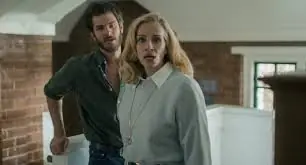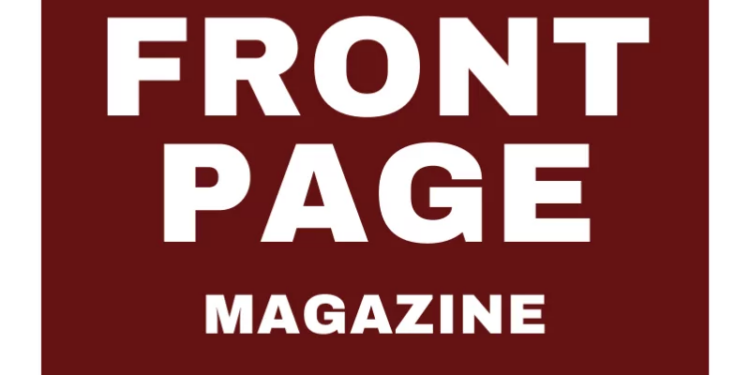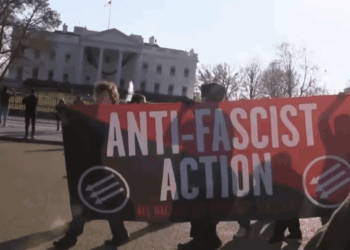
[Order Michael Finch’s new book, A Time to Stand: HERE. Prof. Jason Hill calls it “an aesthetic and political tour de force.”]
After the Hunt is a 2025 psychological thriller. Luca Guadagnino directs. His previous films include Call Me By Your Name and Queer. The title After the Hunt is an allusion to a quote attributed to Otto von Bismarck. “People never lie so much as before an election, during a war, or after the hunt.” Nora Garrett, a first-time screenwriter, wrote the screenplay in a workshop. Garrett was intrigued by the disconnect between a person’s interior life and the persona that one must present in order to be successful. The main character, Alma, a Yale professor pursuing tenure, has “has spent her whole life cordoning off pieces of herself in order to reach this apex … as soon as she’s there … circumstances … occur that would make it so that she could no longer successfully keep those other parts of her away from the identity that she projects out into the world.”
After the Hunt stars Julia Roberts (Alma), Ayo Edebiri (Maggie), Andrew Garfield (Hank), Michael Sthulbarg (Frederik), and Chloe Sevigny (Kim). Lio Mehiel, a woman who identifies as a man, plays Alex, Maggie’s lover. Mehiel has undergone double mastectomy as part of her self-identification as male. Her mastectomy scars are on display in After the Hunt. In an unnecessary scene, she removes her shirt to expose them.
Alma’s desire for tenure is complicated when her pet student, Maggie, accuses Hank, Alma’s friend and partner in extramarital flirtation, of sexual assault. Exactly what constitutes “sexual assault” is never specified. Hank may or may not have kissed or fondled or penetrated Maggie. After the Hunt does not dramatize what transpired between Maggie and Hank, so viewers never learn whether Maggie or Hank is telling the truth.
After the Hunt opened in the US on October 10, 2025. Its runtime is 139 minutes. The film has a 39% positive professional reviewer score at Rotten Tomatoes, and a 36% amateur reviewer score. Google reviews, by amateur reviewers, include many more one-star reviews than reviews with any other score. After the Hunt is a significant box office bomb. It has made a measly $5 million, nowhere near estimated production costs.
In an October 13 New York Times op ed, “The New Julia Roberts Movie Seethes With Anti-Woke Resentment,” Michelle Goldberg writes that After the Hunt depicts “the backlash against self-righteous progressivism cresting, and taking on sanctimonious college students seemed, at least in some circles, like a brave provocation … Now, at a moment of ferocious federal government repression of the campus left, After the Hunt is a bit of a silly anachronism.”
Below, I’ll provide a summary of the film’s plot, including spoilers, and then my own thoughts about whether or not Goldberg is correct, and After the Hunt is worth paying attention to because it “seethes with anti-woke resentment.”
Though After the Hunt never makes clear whether Professor Hank assaulted student Maggie or not, the film seems to take sides in its title sequence. Woody Allen famously begins his films with white letters in Windsor font on a black background; see here. Guadagnino does the same. Is he taking sides? Reporters asked Guadagnino this question; in a long, ambiguous reply, he declined to answer directly, keeping to his film’s refusal to take a clear stand.
Director Guadagnino, cinematographer Malik Hassan Sayeed, and production designer Stefano Baisi exerted a great deal of energy to create a visually lush movie. For just one example, Baisi and Guadagnino imagined a multi-generational history behind Alma and Frederik’s apartment, and placed specific pieces of furniture and books in the apartment, though viewers barely see the books. “Every item in their study and every book was selected in relation to the characters … It’s all very specific.”
Two scenes in the film take place in a New Haven Indian restaurant. The film was shot on nine soundstages and a backlot at London’s Shepperton Studios. “The Indian restaurant in the movie was built on the backlot,” Baisi explains, “complete with sidewalks, tarmac, signs, the facade of the building. Everything is an exact replica of a real place in New Haven, which we measured and photographed. Rather than filming at Yale, “we built a very large quad. We used real iron for the fence, wood for the benches, and real grass. We did molds and used concrete to create the stone sidewalks. And the trees – part of them were built with Styrofoam-type material, which we painted.”
After the Hunt opens in Alma and Frederik’s apartment. The lighting is dim and will remain dim throughout the film. At times the lighting is so dim that the viewer cannot make out facial expressions. Alma is a Yale professor, and Frederik is a psychotherapist, and their apartment communicates their elite status. The walls are rich wood paneling. The furniture is expensive-looking.
Alma is hosting both her professorial colleagues and her students. The difference in status and power between the guests is consciously muddied. Both professors and students strive to pretend as if everyone were equal. Alcohol and obscenities flow freely. Hank, a professor, is dressed in jeans. He places his feet on furniture and is touchy-feely with females. Alma wears mostly all-white clothing throughout the film. Hank and Alma share a cigarette.
Frederik brings in a tart he has made. When they are alone, Frederik tells Alma that she chooses to mentor students who worship her. “Is Maggie brilliant, or do you like her because she thinks you are brilliant?”
Maggie goes to Alma’s bathroom, and opens a cabinet. She finds an envelope, opens it, examines the contents, and keeps one sheet of paper.
Alma kisses Maggie. Hank and Maggie leave the party together.
Alma vomits loudly into a toilet. She will do this multiple times throughout the film. She also takes what looks like prescription medication.
Alma is shown in class. She is addressing Foucault’s concept of the panopticon. “Panopticon” comes from Greek words meaning all seeing. Alma is telling her students that modern societies observe and discipline the citizenry.
Frederik texts Alma that he is making cassoulet for dinner. She ignores him. Hank texts Alma to invite her for drinks. Alma accepts Hank’s offer and misses dinner with Frederik. Hank kisses Alma but leaves after drinking and Alma is left to pay.
When Alma arrives at her apartment, Maggie is waiting for her in the hall. Maggie tells Alma that after her party, Hank walked her home and sexually assaulted her. Maggie refuses to provide any details, so neither Alma nor the audience knows exactly what Maggie means by “sexual assault.”
Alma enters her apartment. Frederik says that Alma missed the cassoulet. Alma claims that she was late because she was working, though in fact she was with Hank. Frederik caresses Alma. Alma pulls away. Hank asks if anything has happened. Alma lies and says “No.”
Alma and Hank meet at Tandoor, a New Haven Indian restaurant with mirrored walls. As they speak, the viewer sees them and also their reflections. This is all meant to be very deep and symbolic. What is real? Their corporeal selves, or their reflections in the mirrored walls?
Hank is wearing a denim shirt and a rag wool sweater. He orders a large amount of food and eats with gusto, often with his mouth open. He is a man of big appetites, the film is telling us. Hank says that he didn’t assault Maggie; rather, he caught her cheating and plagiarizing and wanted to talk to her about that. Of course a professor walking a student home after a party late and night, while he is drunk, is not the ideal time to discuss cheating and plagiarism.
A complicating issue: Maggie’s parents donate large sums of money to Yale.
Alma meets with a dean. He offers her a drink of Jameson whiskey. He says he doesn’t like the Laphroaig he keeps in his office for show, and prefers the less expensive drink – this detail provides more support for the film’s “appearance vs reality” theme. He announces a formal inquiry. Alma attends a book talk entitled, “The Future of Jihadism is Female.” Later, at her apartment, she retrieves the envelope she keeps in the bathroom, realizes something is missing, and burns the entire envelope and its contents. Yale fires Hank. Hank says that Maggie ruined his life.
Maggie and Alma meet in Alma’s kitchen. Frederik walks in and out of the kitchen repeatedly, while playing loud rock music. Frederik torments Maggie with the loud music and snotty remarks.
Alma meets with Kim, a psychotherapist at Yale. While Kim is in the bathroom, Alma rifles through Kim’s purse. Later, on campus, Alma will steal a prescription pad page from Kim. Alma does this in order to illegally purchase opioids.
Maggie tells her tale to the campus newspaper.
Frederik is shown watching internet porn. He complains to Alma that they don’t have sex. Alma has repeatedly rejected Frederik emotionally; apparently she also rejects him physically. Alma also rejects his cassoulet.
The piece of paper Maggie stole from Alma’s bathroom cabinet is a newspaper article. Maggie is shown reading it. It is about a man Alma had accused of sexual assault when she, Alma, was fifteen years old.
Alma is shown teaching her philosophy seminar. She is mean to the students and they are fearful of her. She browbeats a student for thinking in modern day, politically correct terms while reading about an incident from the story of Ulysses in the court of Phaeacian king Alcinous. Ulysses is traveling incognito. A minstrel sings of the Trojan War. Ulysses recognizes the minstrel’s song as being about himself, and he weeps, thus blowing his cover and revealing his true identity.
A disciplinary committee calls in Alma. She has stolen a prescription sheet from Kim, and her attempt to gain tenure is suspended. This passage is alluded to in the film for the same reason that Alma and Hank ate at Tandoor restaurant, with its mirrored walls.
Alma confronts Maggie and is verbally abusive. She unleashes a tirade against Woke culture on campus. You are mediocre, Alma says. You plagiarize. You want trigger warnings and you always want to be comfortable. Not everything is supposed to be comfortable. You are privileged and yet needy. Maggie slaps Alma.
Alma retreats to a dingy apartment she rents on New Haven’s Wharf. She finds Hank in the apartment. We are to assume that he is now homeless. Alma had given him a key to this place, her secret hideout, months previously and never retrieved the key. Hank and Alma kiss. At first the kiss is consensual, but Alma wants Hank to stop, and he does not. She pushes him away. He leaves the apartment, barefoot, and not wearing any pants.
On the Yale campus, students surround Alma. Maggie has spread negative reports about Alma. The students want revenge. Alma falls to the ground.
Alma is in a hospital room. Frederik is beside her bed. He tells her that she has several perforated ulcers. Alma tells Frederik that when she was fifteen, she had a crush on one of her father’s friends. He responded to her, but later he dumped her for another woman. In revenge, she alleged that he assaulted her. Then she withdrew the accusation. Years later, he committed suicide and she feels responsible. Frederik tells her that she was not responsible. She says that she still loves the man. Frederik says that he loves Alma. Alma does not reciprocate.
It is now five years after the main action of the film. Alma has gotten tenure. Hank is making money in politics. Alma and Frederik are still together. Maggie is happy in her life. The end.
After the Hunt stinks so bad staff have to spray theaters with Febreze after every showing.
In 1994, David Mamet wrote and directed a movie, Oleanna. In that film, Carol, a student, accuses John, her professor, of sexual harassment. The film shows you everything that transpires between John and Carol. Mamet’s film is, as one would expect from a Pulitzer-Prize-winning author, masterfully written and directed. I disagreed with what I took to be the film’s point – that the real problem we should be paying attention to is false or ambiguous accusations of harassment from overreacting, power-drunk females. I recognize that false accusations occur, but I think the bigger problem is male-on-female violation. Even so, I’d have to give Oleanna at least four out of five stars because it is well-made.
After the Hunt doesn’t stink because of its politics. It is too cowardly and too incoherent to advance any politics. After the Hunt stinks because of a more catastrophic cultural trend. After the Hunt is a massive failure of storytelling. Differences in politics come and go, but when some of our most celebrated and well-remunerated storytellers have no idea that they are marketing a train wreck as clanky as this, and these train wrecks are rewarded over and over, that’s a sign of something really wrong with society.
Was it the early 2000s that this trend began? When the films that won the Best Picture award at the Oscars were movies that few people liked, and even fewer people saw? Recent celebrated films that insisted that they were all about big ideas that society really needed to hear, but were actually films that couldn’t tell a coherent story include The Brutalist, Eddington, and One Battle after Another. After the Hunt has not been elevated by critics as have the others in this category. Why? it offers some weak-tea criticism of Woke. Folks like Michelle Goldberg insist that After the Hunt is a right-wing movie, so they hate it.
Michelle Goldberg should have saved her thunder. After the Hunt is the cinematic version of the Gish Gallop. The Gish Gallop is a logical fallacy. The speaker vomits up a series of truths, half-truths, and lies that have no logical connection to each other. No point leads to any other point. The Gish Gallop runs rampant on the internet, where there is little to no moderation, and anyone with a grab-bag of talking points can think that he has a coherent narrative. The Gish Gallop is the perfect logical fallacy for our era of short attention spans and speaker-friendly lies posing as cold, hard truth. Everyone involved in After the Hunt seems utterly sincere. The problem is they ignored the real trees, and painted Styrofoam to look like trees. We all need fact-checkers to make sure our grab-bags don’t contain counterfeit currency.
Some of the film’s grab-bag of unconnected, implausible, pseudo-facts:
Why did the film make Alma a German-speaking Swede? She had the affair with the German pedo when she was fifteen. That’s well after fossilizes. Alma should have had a German accent. She did not.
Alma stores her most precious mementos in the toilet paper cabinet of her bathroom? No.
Maggie’s last name is Resnick. Resnick is an Ashkenazi name. Ayo Edebiri is plainly the daughter of a Nigerian father, that is, not Jewish.
Hank is immediately fired from Yale, and rendered homeless, because one student, whom he has caught cheating and plagiarizing, makes an unsubstantiated accusation. On what planet does this happen? When I was at Indiana University, a professor and the university both publicly acknowledged, as part of their lawsuit, that that professor forcibly fondled and kissed an unwilling victim and they kept him teaching students in class. It took years, dozens of accusations, and expensive legal action to terminate this professor.
In the New York Times’ comments section, a recent Yale grad wrote, “There were multiple instances in my own department of graduate students accusing the faculty of inappropriate behavior … the student was either bullied out of the department or ignored with little or no consequences for faculty.” I witnessed similar events when I was a professor in recent years and students came to me with complaints. Overt harassment was excused by higher-ups. The bottom line is power. If the accused is someone who provides the university with a commodity that benefits the university, the university will, all other factors being equal, protect the accused.
Alma, the film tells us, has multiple perforated ulcers. She is also an alcoholic and an opioid addict. Yet she is beautiful, poised, and able to maintain a high-powered Ivy League career. This is not medically possible.
Toss this grab-bag of implausible facts into a series of sensationalized scenes meant to scratch contemporary itches. The filmmakers believe that they are creating a film that addresses current headlines. Alma steals prescription pad pages! Married but loveless Frederik pleasures himself while watching internet porn! Hank jumps on Alma, testing the concept of consent! Alex shows off her mastectomy scars! None of these sensationalized scenes serve a throughline narrative because there is no throughline narrative.
Do we really have to drag filmmakers back to high school English class? A storyteller begins with a compelling, rounded character who wants something she doesn’t have. As the old-timer storytellers say, “You drive your character up a tree and throw rocks at him.” You erect barriers between your character and what he wants. Gone with the Wind is 1,037 pages long. One page one, Scarlett O’Hara wants Ashley Wilkes. On page 1,037, she doesn’t have Ashley Wilkes, and, furthermore, she realizes that wanting him was pretty foolish and self-sabotaging. Everything that happens in the intervening 1,037 pages serves that single line of narrative. Hamlet must avenges his father’s murder. Period. One sentence!
Robert McKee, a masterful teacher of storytelling skill, tells his many students that they must be able to convey the gist of their story in one sentence. That isn’t just important for an “elevator pitch,” so that the next time you are in an elevator with Steven Spielberg, you can convince him to turn your novel into a movie. That’s important for the writer. If your story can’t be reduced to one or two sentences, chances are you aren’t writing a story; you are, rather, jotting down a series of thoughts – a Gish Gallap – that aren’t gelling into that powerful machine, a real story.
There’s plenty onscreen in After the Hunt that, with the same cast, the same set design, the same snarky rants against Woke and also the rants against the patriarchy and white supremacy could have made for a really good film.
Alma, an alcoholic, opioid addict, and ulcer sufferer, struggles to get tenure. There’s your movie.
Hank, a charming rogue who breaks the rules of scholarly tradition, navigates a false or even true allegation of sexual assault. There’s your movie.
Frederik, a doormat of a man, who takes on roles most frequently assumed by women – he cooks, he massages, he encourages, he adores – stays with a woman who not only plainly does not love him, but who also carries on an on-again-off-again affair with Hank, a younger, hotter colleague. Bingo. A movie.
To make any of the above movies you’d have to have something more than a TikTok-sized attention span and a bagful of true, partially true, or utterly false takes on popular culture and current events. You’d have to have patience and care and a politics-transcending commitment to the integrity of the story you are telling.
Storytelling is essential to the human experience. It’s how we, without being physically intimate, touch each other most intimately. I remain moved by stories I heard decades ago. Stories changed my life. What does it say about our society that so many films lately, especially “prestige” films like After the Hunt, botch the most basic element – a coherent narrative? Nothing good, I’m afraid.
All is not lost. Please consider spending your movie-going dollars on two new films. Good Boy is a 2025 horror movie starring a dog. I’m not into horror films, but I am into dogs, so I had to see Good Boy. The film is short, only 73 minutes. It’s low-budget. There are no famous actors. Director and co-writer Ben Leonberg has no previous feature film credits. He filmed Good Boy in his own house using his own dog over the course of three years. It took so long because Indy, the dog, had a limited attention span to perform on camera before he wanted treats, tennis balls, and couch time.
Good Boy is scary, but I think even kids, if their parents are with them, could watch it and be okay. Good Boy has a surprise, twist ending that upends the entire movie. Good Boy becomes more than just a spooky story starring an utterly gorgeous dog who gives, truly, one of the top performances of the year. Good Boy tackles one of the monsters we all have to face, eventually. Many viewers report bursting into tears – good tears – at the end of Good Boy when they realize how truly deep and utterly human this film is. As a YouTube commenter put it, “If you have a dog, watch this. I’m dead inside and even I teared up at the end.” It is remarkable to me that one of the best stories released in theaters this year came from a nobody in the film industry working with almost no budget and just a stunningly beautiful dog.
Blue Moon is the second film I want you to support by buying a ticket. Blue Moon is a biopic about lyricist Lorenz “Larry” Hart (1895 – 1943). Hart gave us such classics as “Blue Moon,” “I wish I Were in Love Again,” and “The Lady Is a Tramp.” Hart wrote one of my favorite lyrics:
When love congeals
It soon reveals
The faint aroma of performing seals
The double-crossing of a pair of heels
I wish I were in love againSinatra swings it here.
Blue Moon is directed by Richard Linklater. The literate, profound, sometimes funny, sometimes heart-breaking, but always razor-sharp script is by Robert Kaplow. The cast includes Ethan Hawke (Hart), Andrew Scott (Richard Rodgers), Margaret Qualley (Elizabeth Weiland), Bobby Cannavale (Eddie, The Bartender), Patrick Kennedy (EB White), Simon Delaney (Oscar Hammerstein II), Cillian Sullivan (Stephen Sondheim), and John Doran (Weegee).
Hart was a tortured genius. He was short, only five feet tall, balding, alcoholic, depressive, and probably gay, although he did propose marriage to two women, both of whom rejected him. So, who wants to watch a biopic about this guy? Me, and I’m so glad I did. Most of Blue Mon consists of Hart, monologuing at the bar in Sardi’s restaurant. Sardi’s is a famous theater hangout. Hart delivers his monologues to anyone whose ear he can bend.
All of the action takes place the night of the 1943 opening of Oklahoma! Lyricist Hart and composer Richard Rodgers had been partners since 1919. They collaborated on twenty-eight musicals and co-wrote five hundred songs. Hart’s personal problems came between them. Hart would disappear for days at a time. He was an alcoholic.
Oklahoma! was Rodgers’ first collaboration with lyricist Oscar Hammerstein II. Oklahoma! was a very different musical than Rodgers and Hart had worked on. It integrated story and musical numbers more tightly, but there was more than that. Hammerstein was a very different person than Hart. He would go on to write lyrics that cynics would dismiss as “corny” but that fans would embrace as “warm,” “inspirational,” and even, in the case of “You’ve Got to be Taught,” “ethical.” Hart, on the other hand, was a clever man given to a jaundiced view of the human condition. His song “To Keep My Love Alive,” for example, describes a woman killing one lover after another. Rodgers had invited Hart to work with him on Oklahoma! but Hart declined. He felt no sympathy for a musical about “cowboys.” Oklahoma! became a huge success from its opening night to this day, eighty-two years later.
In Blue Moon, Hart recognizes that his style of art is on the decline, and Rodgers and Hammerstein’s star is rising. There’s another heartache for Larry. He is obsessed with Elizabeth Weiland, a young woman affiliated with Yale university. Elizabeth “loves” Larry as a mentor who can help her theater career, but she feels no romantic love for a physically unattractive, self-loathing, gay man more than twice her age.
Fans of Blue Moon want Ethan Hawke to win an Academy Award. Yes, his performance is impressive, but for this viewer the secondary characters light up the screen. Andrew Scott is stunning as Richard Rodgers. Scott conveys Rodgers’ genuine respect for and gratitude to Hart, but also his refusal to continue tolerating a colleague’s erratic and self-destructive behavior. And there’s more. Rodgers acknowledges that it’s no longer the Roaring Twenties. It’s the middle of World War II, and people need musicals that will uplift them, as Oklahoma! is doing. Rodgers tells Hart that his clever cynicism is not as smart as Hart thinks it is. The two cross swords on a stairwell in a confrontation whose only weapon is dialogue, but that became so charged I squirmed.
Hart talks a great deal about Elizabeth before she appears onscreen. I was wondering, how the heck is this movie going to sell a relationship between a twenty-something beauty and this unattractive, verbose, drunk? The script, and Margaret Qualley’s performance, generate subtle magic. Elizabeth is shown to be a good-hearted girl who recognizes and appreciates Hart’s genius, and his worship of her. She’s also as savvy as a jewel thief and she knows how to take advantage of Larry without letting him touch her in any significant way.
I’d watch the entire movie all over again just to enjoy Patrick Kennedy’s performance as EB White. Screenwriter Kaplow “invited” White, a novelist and prose stylist, into Sardi’s bar on this night in order to give Hart another writer to talk to. Kennedy’s performance felt so real to me I was completely submerged in willing suspension of disbelief and I felt as if they had somehow resurrected the real EB White. White is alternately collegial with Hart, his respected fellow wordsmith, indulgent of Hart, a man who clearly is on his last legs, and inspired by Hart, who, in Kaplow’s fictional flourish, prompts White to write his novel Stuart Little.
Blue Moon is not for everybody. The action is all in the dialogue. Hart was not, to this viewer, a sympathetic character. I’m immune to extending my compassion to active addicts. Hart will, shortly after the action of this film, get drunk, collapse in a cold rain, and die of pneumonia. I loved this movie anyway. It brought a character to full life. It educated me about a significant chapter in American artistic history. It invited me to consider whether I am more appreciative of sardonic wit or warm-hearted sentiment. I probably love both equally.
There’s a brief, but good, documentary about Rodgers and Hart here. There’s a salute to Oscar Hammerstein II’s “humanism” here.
Danusha V. Goska is the author of God through Binoculars: A Hitchhiker at a Monastery.

















